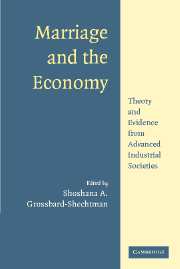Book contents
- Frontmatter
- Contents
- List of Figures
- List of Tables
- List of Contributors
- Foreword
- Acknowledgments
- Marriage and the Economy
- 1 Marriage and the Economy
- PART I THE ECONOMICS OF MARRIAGE AND DIVORCE
- PART II EFFECTS OF MARRIAGE ON INCOME USES
- PART III EFFECTS OF MARRIAGE ON TIME USES
- 9 Marriage, Household Production, and Earnings
- 10 Marriage and Work for Pay
- 11 Marriage, Work for Pay, and Childcare
- 12 Marriage and Home-Based Paid Employment
- PART IV MARRIAGE AND THE MACROECONOMY
- Index
12 - Marriage and Home-Based Paid Employment
Published online by Cambridge University Press: 07 December 2009
- Frontmatter
- Contents
- List of Figures
- List of Tables
- List of Contributors
- Foreword
- Acknowledgments
- Marriage and the Economy
- 1 Marriage and the Economy
- PART I THE ECONOMICS OF MARRIAGE AND DIVORCE
- PART II EFFECTS OF MARRIAGE ON INCOME USES
- PART III EFFECTS OF MARRIAGE ON TIME USES
- 9 Marriage, Household Production, and Earnings
- 10 Marriage and Work for Pay
- 11 Marriage, Work for Pay, and Childcare
- 12 Marriage and Home-Based Paid Employment
- PART IV MARRIAGE AND THE MACROECONOMY
- Index
Summary
In recent years, the growing labor force participation of married women, coupled with their continuing household responsibilities, has led to an increased demand for a host of flexible work arrangements such as parttime work, contingent work, and work with variable scheduling. Another work arrangement that offers this flexibility, and may in addition reduce the costs of work, is home-based paid employment. In this chapter, we examine the relationship between a woman's marital status and her likelihood of choosing to be a home-based worker.
Past decades have seen a steady rise in the labor force participation rates of women, from 45.9 percent in March 1975 to 59.8 percent in September 1999 (Howard Hayghe 1997; U.S. Department of Labor, Bureau of Labor Statistics 1998). The increase has been particularly note-worthy for married women, especially those with small children. Although the recession of the early 1990s led to a slowdown in the growth in women's participation rates, since 1994 women's labor force participation has once again begun to grow steadily. The biggest increase has been among women with young children, of whom the vast majority are marrie d with a spouse present. From 1975 to 1996, the participation rate for mothers whose youngest child was in school rose 22 percent, and the rate for mothers of preschoolers rose 24 percent (Hayghe 1997).
Despite this growth in labor force participation, women remain largely responsible for the care of family and home. This “second shift” adds about twenty hours to the total weekly work hours of women who are in the labor force, in contrast to just seven hours for comparable men (Joni Hersch and Leslie S. Stratton 1994).
- Type
- Chapter
- Information
- Marriage and the EconomyTheory and Evidence from Advanced Industrial Societies, pp. 271 - 290Publisher: Cambridge University PressPrint publication year: 2003



